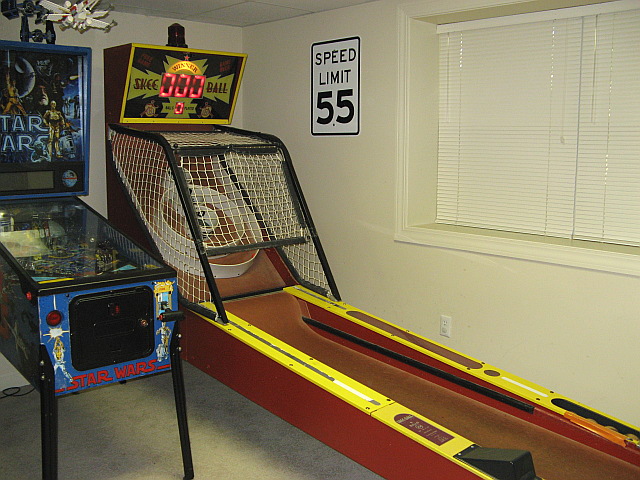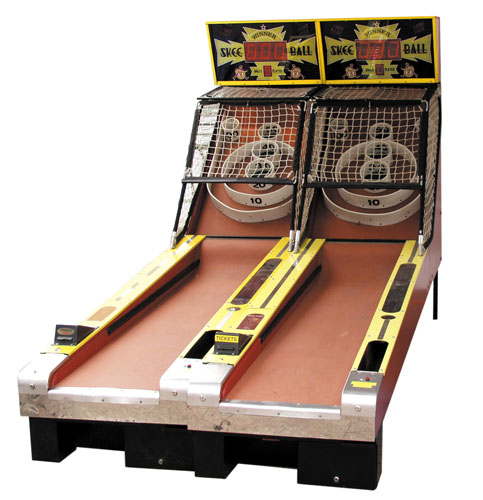The History of Skee-Ball Machines

Photo: Model H Skee-Ball
http://www.idleamusements.com/Electronics/Skeeball.htm
The Popular "Model H" Alley
Possibly the most popular Skee-ball alleys are the "Model H" and "Model S" alleys. These machines are instantly recognizable, with red-and-yellow color scheme. Each of these CPU modules were total redesigns of the previous solid state boards that were used and were microprocessor based instead of entirely logic chip based. The alleys offered a large improvement to the previous solid state Skee-balls.
The Model H alley debuted around 1981 (schematics from Model H are actually dated July 1982). There was both a CPU module / logic board and a Power Supply Module, possibly so that operators didn't have as big of a box to ship if a module needed repair. These modules were accessible from the front of the machine, a huge advantage on previous model Skee-Ball machines that required access to the back of the machine. The CPU board was microprocessor-based (INS8060 CPU) which both reduced the number of ICs required while also giving the operator more control over the game.
This was also the first model Skee-ball with high quality sound effects and musical selections built into the CPU board. The first winning score was usually programmed at the factory, unless a thumb wheel switch for adjustable win-select was installed (available on alleys without ticket dispensers). There were various field programmable options which could be programmed via dip switches on the CPU board for number of balls, free game award, number of coins and enabling/disabling the ticket dispenser.
Something else the Model H added was better diagnostic information for the operator. If there was an issue with the ticket mechanism the letters "HEL" "P" would appear on the score displays (later changed to "CAL" "L" due to parents complaints about the machines telling their kids to go to H*LL). This assisted operators in identifying which boards might be having issues in the machine.
The wiring harnesses for Model D & Model E Skee-ball machines are different than a Model H, so no previous harnesses could be used. These alleys could be purchased with or without the "bonus ball" option (ie. 100pt pockets).
The "Model H" was initially produced in 10ft and 13ft lengths. In
1983, in response to growing demand for smaller alleys, Skee-Ball
produced 6ft and 8ft versions of their alleys. Four player versions of
the Model H were introduced in 1986 and allowed for competitive play for
up to four players and also allowed for dispensing of point-winning
tickets. This was also the last model Skee-ball that Deltronic Labs,
Inc. manufactured the main circuit boards for.
A neat item made for the Model H by Deltronic Labs was a Deltronic Skee
Ball Alley Simulator. Basically this was a bench test fixture that
could be used when repairing Model H (and possibly Model S) logic boards without
having to connect the board to the actual machine.
The Sale of Skee-Ball, Inc.
In 1985 the Skee-Ball Inc. division of the Philadelphia Toboggan Company was sold to Joseph W. Sladek, who has been CEO since. Sladek has been vice president of finance of a New York publishing company, but wanted to move back to Philadelphia with his family. He was looking for a business he could invest in and it just so happened that Philadelphia Toboggan Company was ready to sell the Skee-Ball division at that time. The Philadelphia Toboggan Coasters, Inc. as it's known today, is based in Landsdale, PA and has built coasters, carousels, fun houses and other rides for amusement parks. Specifics on why they sold the Skee-Ball, Inc. division in 1985 are unknown at this time.

Photo: Model S Skee-Ball
Photo credits unknown
The Popular "Model S" Alley
Following on the heels of the very popular Model H alley was the Model S. The schematics are dated February 1988, so it can be assumed the Model S was being produced sometime around 1988-1989. The Model S was based on the "Intel 8085", an 8-bit microprocessor produced by Intel in 1977. This model also had the option of having two 100pt pockets at the top of the scoring board which were quite challenging to hit. It also featured sound effects and would play a tune at start-up and sound effects when scoring. Operators could program all game settings on location, whereas previously some game settings could still only be set at the factory.
These alleys could be purchased with or without the "bonus ball"
option (ie. 100pt pockets). The wiring for the 100pt switches was
installed in the head of the game either way. This would have given the
operator the option of purchasing the additional 100pt ball chute and
switches from Skee-ball to convert over to 100pt pockets.
The wiring harnesses for a Model S are different than a Model H, so the harnesses are not interchangeable.
The "Model S" was produced in both 10ft and 13ft versions and its highest point value was 100pts. Near the end of production they started using large 7 segment LED digits in favor of the #73/#74 bulb-based displays. Four play displays could also be added to this alley to allow for competitive play for up to four players.
The "Skee-Ball Progressive Jackpot" could be added to Model S machines. This is a jackpot continues to grow as people play on multiple Skee-Ball machines that are lined up next to eachother. When someone reaches a certain score, they win the Jackpot. Each player receives 3 balls for 3 rounds.
page1 page2 page3 page4 page5Comments:
| Origin of Skee Ball Machine |
| Posted 03/17/12 3:37AM by Anonymous Techdoser |
| I KNOW where the name "Skee Ball" came from....do you know where it came from? |
